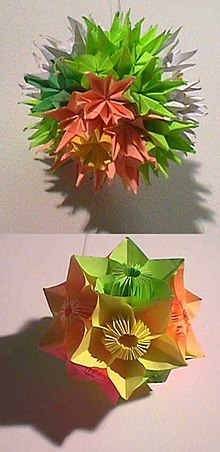
The Japanese kusudama (薬玉; lit. medicine ball) is a paper model that is usually (although not always) created by sewing multiple identical pyramidal units together using underlying geometric principles of polyhedra to form a spherical shape. Alternately the individual components may be glued together. (e.g. the kusudama in the lower photo is not threaded together) Occasionally, a tassel is attached to the bottom for decoration.[1]
The term kusudama originates from ancient Japanese culture, where they were used for incense and potpourri; possibly originally being actual bunches of flowers or herbs.[2] The word itself is a combination of two Japanese words kusuri ("medicine") and tama ("ball"). They are now typically used as decorations, or as gifts.[3]
The kusudama is important in origami particularly as a precursor to modular origami. It is often confused with modular origami, but is not such because the units are strung or pasted together, instead of folded together as most modular construction are made.[4]
It is, however, still origami, although origami purists frown upon threading or gluing the units together, while others recognize that early traditional Japanese origami often used both cutting (see thousand origami cranes or senbazuru) and pasting, and respect kusudama as an ingenious traditional paper folding craft in the origami world.
Modern origami masters such as Tomoko Fuse have created new kusudama designs that are entirely assembled without cutting, glue, or thread except as a hanger.[5]
- ^ "7 Steps to a Pretty Origami Kusudama Flower". The Spruce Crafts. Retrieved 2018-07-24.
- ^ "Step-By-Step Kusudama Flower Ball". Home Decorating Trends - Homedit. 2016-03-16. Retrieved 2018-07-24.
- ^ "Traditional Japanese kusudama". origami-art.us. Retrieved 2018-07-24.
- ^ "David Lister on Kusudamas". www.britishorigami.info. Retrieved 2018-07-24.
- ^ mulatinho. "origami-galerie". www.origami-galerie.de. Retrieved 2018-07-24.